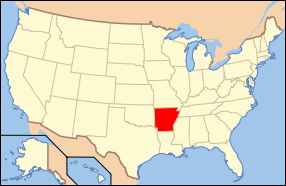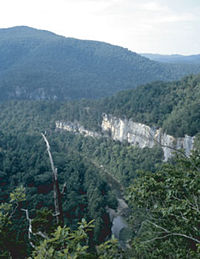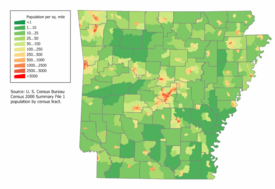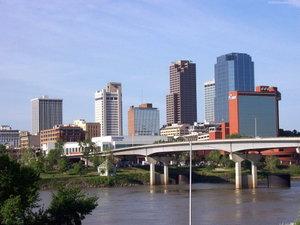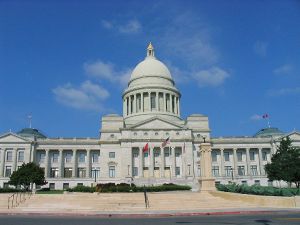Arkansas
| State of Arkansas | |||||||||||
| |||||||||||
| Official language(s) | English | ||||||||||
| Capital | Little Rock | ||||||||||
| Largest city | capital | ||||||||||
| Largest metro area | Little Rock Metropolitan Area | ||||||||||
| Area | Ranked 29th | ||||||||||
| - Total | 53,179 sq mi (137,733 km²) | ||||||||||
| - Width | 239 miles (385 km) | ||||||||||
| - Length | 261 miles (420 km) | ||||||||||
| - % water | 2.09 | ||||||||||
| - Latitude | 33° 00′ N to 36° 30′ N | ||||||||||
| - Longitude | 89° 39′ W to 94° 37′ W | ||||||||||
| Population | Ranked 32nd in the U.S. | ||||||||||
| - Total | 2,937,979 (2011 est)[1] | ||||||||||
| - Density | 56.4/sq mi (21.8/km2) Ranked 34th in the U.S. | ||||||||||
| Elevation | |||||||||||
| - Highest point | Magazine Mountain[2][3] 2,753 ft (839 m) | ||||||||||
| - Mean | 650 ft (200 m) | ||||||||||
| - Lowest point | Ouachita River at Louisiana border[2][3] 55 ft (17 m) | ||||||||||
| Admission to Union | June 15, 1836 (25th) | ||||||||||
| Governor | Mike Beebe (D) | ||||||||||
| Lieutenant Governor | Mark Darr (R) | ||||||||||
| U.S. Senators | Mark Pryor (D) John Boozman (R) | ||||||||||
| Time zone | Central: UTC-6/DST-5 | ||||||||||
| Abbreviations | AR Ark. US-AR | ||||||||||
| Web site | www.arkansas.gov | ||||||||||
Arkansas (are-can-saw) is a state located in the southern region of the United States of America. Arkansas shares a border with six states, with its eastern border largely defined by the Mississippi River. Its diverse geography ranges from the mountainous regions of the Ozarks and the Ouachita Mountains, which make up the interior highlands, to the eastern lowlands along the Mississippi River. The capital and most populous city is Little Rock, located in the central portion of the state.
Little Rock became the center of international attention in 1957 when then Gov. Orval Faubus sent the Arkansas National Guard to prevent nine African-American students from enrolling at Central High School. In response, President Dwight D. Eisenhower sent 1,000 paratroops to escort the African-American students. This incident eventually led to the closing of Little Rock high schools for the rest of the school year, but the schools were completely integrated by the fall of 1959.
Early Spanish or French explorers gave the state its name, which is probably a phonetic spelling for the Illinois tribal word for the Quapaw people, who lived downriver from them. The pronunciation "arkansaw" was made official by an act of the state legislature in 1881.
Geography
The Mississippi River forms most of Arkansas's eastern border, except in Clay and Greene counties where the St. Francis River forms the western boundary of the Missouri Boot-heel, and in dozens of places where the current channel of the Mississippi has meandered from where it had last been legally specified.[4] Arkansas shares its southern border with Louisiana, its northern border with Missouri, its eastern border with Tennessee and Mississippi, and its western border with Texas and Oklahoma.
Arkansas is a land of mountains and valleys, thick forests and fertile plains. Northwest Arkansas is part of the Ozark Plateau including the Boston Mountains, to the south are the Ouachita Mountains, and these regions are divided by the Arkansas River. The mountain ranges are part of the interior highlands of the United States, the only major mountainous region between the Rocky Mountains and the Appalachian Mountains.[5][6] The highest point in the state is Magazine Mountain in the Ouachita Mountains; it rises to 2,753 feet above sea level.
The southern and eastern parts of the state are called the Lowlands but are better known by the names of their two regions, the Delta and the Grand Prairie. The Arkansas Delta is a flat landscape of rich alluvial soils formed by repeated flooding of the adjacent Mississippi. Farther away from the river, in the southeast portion of the state, the Grand Prairie consists of a more undulating landscape. Both are fertile agricultural areas.
The Delta region is bisected by an unusual geological formation known as Crowley's Ridge. A narrow band of rolling hills, Crowley's Ridge rises from 250 to 500 feet above the surrounding alluvial plain and underlies many of the major towns of eastern Arkansas.
Arkansas is home to many caves, such as Blanchard Springs Caverns. It is also the first U.S. state in which diamonds were found, near the city of Murfreesboro.[7]
Arkansas is home to many areas protected by the National Park System, including Hot Springs National Park. The Trail of Tears National Historic Trail also runs through the state.
Climate
Arkansas generally has a humid, subtropical climate. While not bordering the Gulf of Mexico, Arkansas is still close enough to this large, warm body of water for it to be the main weather influence in the state. Generally, Arkansas has very hot, humid summers and mild, slightly drier winters. Annual precipitation throughout the state averages between about 40 and 60 inches (1,000 to 1,500 mm), though it is somewhat wetter in the south and drier in the northern part of the state.[8] While snowfall is not uncommon, the amounts are low in most years; the average snowfall is around 5 inches (13 cm).[9]
Despite its subtropical climate, Arkansas is known for occasional extreme weather. Located between the Great Plains and the Gulf states, Arkansas receives around 60 days of thunderstorms per year. As a part of Tornado Alley, tornadoes are a common occurrence, and a few of the most destructive tornadoes in U.S. history have struck the state. While being sufficiently away from the coast to be safe from a direct hit from a hurricane, Arkansas can often get the remnants of tropical systems that dump tremendous amounts of rain in a short time and often spawn smaller tornadoes.
History
Mississippian culture
The Mississippian culture was a mound-building Native American culture that flourished in an area that included what is now Arkansas from approximately 800 C.E. to 1500 C.E., varying regionally. A number of cultural traits are recognized as being characteristic of the Mississippians, including
- The construction of truncated pyramid mounds, or platform mounds. Structures (domestic houses, temples, burial buildings, or other) were usually constructed atop such mounds.
- Maize-based agriculture. In most places, the development of Mississippian culture coincided with adoption of comparatively large-scale, intensive maize agriculture.
- Widespread trade networks extending as far west as the Rockies, north to the Great Lakes, south to the Gulf of Mexico, and east to the Atlantic Ocean.
- The development of the chiefdom or complex chiefdom level of social complexity that could be comparable at different points to post-Roman, pre-consolidation tribal England.
- A centralization of control of combined political and religious power in the hands of few or one.
- The beginnings of a settlement hierarchy, in which one major center (with mounds) has clear influence or control over a number of lesser communities, which may or may not possess a smaller number of mounds.
The Native American nations that lived in Arkansas prior to the westward movement of American settlers were the Quapaw, Caddo, and Osage nations, all of whom were descended from the Mississippian culture. While moving westward, the Five Civilized Tribes inhabited Arkansas during its territorial period.
European contact
The first European to reach Arkansas was the Spanish explorer Hernando de Soto, who arrived in the mid-sixteenth century. Some encounters were violent, others relatively peaceable. After the destruction and flight of the de Soto expedition, the Mississippian peoples continued their way of life with little direct European influence. Indirectly, however, European introductions would change the face of the Eastern United States. Diseases undermined the social order of many chiefdoms, while some groups adopted European horses and reverted to nomadism. Political structures collapsed in many places. By the time more documentary evidence was available, the Mississippian way of life had changed irrevocably. Some groups maintained an oral tradition link to their mound-building past, while other groups, having migrated many hundreds of miles and losing their elders to diseases, did not remember that their own ancestors had built the mounds dotting the landscape.
The early Spanish or French explorers of the state gave it its name, which is probably a phonetic spelling for the Illinois tribal word for the Quapaw people, who lived downriver from them[10].
Territory and statehood
Arkansas is one of several U.S. states formed from the territory purchased from Napoleon Bonaparte in the Louisiana Purchase. The region was organized as the Territory of Arkansaw on July 4, 1819, and the territory was admitted to the Union on June 15, 1836, becoming the 25th state and the 13th slave state.
Arkansas played a key role in aiding Texas in its war for independence with Mexico, sending troops and materials. The proximity of the town of Washington to the Texas border involved the town in the Texas Revolution of 1835-1836. Some evidence suggests that Sam Houston and his compatriots planned the revolt in a tavern at Washington in 1834. [11] When the fighting began, a stream of volunteers from Arkansas and the eastern states flowed through the town toward the Texas battlefields.
When the Mexican-American War began in 1846, Washington became a rendezvous for volunteer troops. Ten companies of men assembled there and were formed into the first regiment of Arkansas cavalry.
Arkansas refused to join the Confederate States of America until after United States President Abraham Lincoln called for troops to respond to the attack on Fort Sumter, South Carolina, by Confederate forces. The State of Arkansas seceded from the Union on May 6, 1861. While not often cited in history, the state was the scene of numerous small-scale battles during the American Civil War.
Under the Military Reconstruction Act, Congress readmitted Arkansas in June 1868.
In 1905-1911, Arkansas began to receive a small migration of German, Slovak, and Irish immigrants. The German and Slovak peoples settled in the eastern part of the state, and the Irish founded small communities in the southeast. The Germans and Slovaks were all Roman Catholic families. The Irish were usually Protestants from Ulster.
Role in Desegregation
After the desegregation case Brown v. Board of Education of Topeka was decided in 1954, the Little Rock Nine incident brought Arkansas to national attention when the federal government was forced to interfere in the Arkansan capital. Gov. Orval Faubus sent the Arkansas National Guard to aid segregationists in preventing nine African-American students from enrolling at Little Rock's Central High School. President Dwight D. Eisenhower sent 1,000 paratroops to escort the African-American students on September 25, 1957. This incident eventually led to the closing of Little Rock high schools for the rest of the school year, but the schools were completely integrated by the fall of 1959.[12]
Bill Clinton, the 42nd president of the United States, was born in Hope, Arkansas. Before his presidency, Clinton served nearly 12 years as governor of Arkansas.
Demographics
In 2006, Arkansas had an estimated population of 2,810,872, [13] which is an increase of 1.1 percent from the prior year and an increase of 4.0 percent since the year 2000. Immigration from outside the United States resulted in a net increase of 21,947 people, and migration within the country produced a net increase of 35,664 people. It is estimated that about 48.8 percent is male, and 51.2 percent is female. From 2000 through 2006 Arkansas had a population growth of 5.1 percent.
The five largest ancestry groups in the state are: White American - those disregarding ethnicity of ancestry and simply claiming "American" (15.9 percent), African-American (15.7 percent), Irish (9.5 percent), German (9.3 percent), English (7.9 percent).
People of European ancestry have a strong presence in the northwestern Ozarks and the central part of the state. African-Americans live mainly in the fertile southern and eastern parts of the state. Arkansans of Irish, English, and German ancestry are mostly found in the far northwestern Ozarks near the Missouri border.
As of 2000, 95.07 percent of residents age 5 and older speak English at home and 3.31 percent speak Spanish. German is the third most spoken language at 0.299 percent, followed by French at 0.291 percent and Vietnamese at 0.13 percent.[14].
Religion
Arkansas, like most other Southern states, is part of the Bible Belt and is overwhelmingly Protestant. The religious affiliations of the people are as follows:[15]
- Christian – 86 percent
- Protestant – 78 percent
- Roman Catholic – 7 percent
- Orthodox Christian – <1 percent
- Other Christian – <1 percent
- Other Religions – <1 percent
- Non-Religious – 14 percent
Economy
The state's gross domestic product for 2005 was $87 billion. Its per capita household median income (in current dollars) for 2006 was $35,295, according to the U.S. Census Bureau[16]. The state's agriculture outputs are poultry and eggs, soybeans, sorghum, cattle, cotton, rice, hogs, and milk. Its industrial outputs are food processing, electric equipment, fabricated metal products, machinery, paper products, bromine, and vanadium.
In recent years, automobile parts manufacturers have opened factories in eastern Arkansas to support auto plants in other states. The city of Conway is the site of a school bus factory.
Tourism is also very important to the Arkansas economy; the official state nickname "The Natural State" (as in "Arkansas Is a Natural") was originally created for state tourism advertising in the 1970s, and it is still regularly used. Some 600,000 acres of lakes provide opportunities for fishing, swimming, sailing, power-boating, scuba diving and more. The Ozark-St. Francis and Ouachita National Forests offer campgrounds, hiking trails, horseback or ATV trails, scenic drives, picnic areas, shooting ranges, and opportunities to watch wildlife, fish, hunt, or canoe.
According to Forbes.com, Arkansas ranks 21st among the Best States for Business, 9th for Business Cost, 40th for Labor, 22nd for Regulatory Environment, 17th for Economic Climate, 9th for Growth Prospects, 34th in Gross Domestic Product, and positive economic change of 3.8 percent.
Government and politics
Little Rock is the capital and the most populous city of Arkansas, and the county seat of Pulaski County. It is located near the geographic center of the state. According to the 2007 US census, its population was estimated at 187,452. Little Rock, North Little Rock and Conway are co-principal cities of the six-county Little Rock–North Little Rock–Conway Metropolitan Statistical Area, an area with a population of 666,401 people, according to 2007 census estimates. That region is in turn included in the larger Little Rock–North Little Rock–Pine Bluff Combined Statistical Area, which had a population of 841,325 in the 2007 census estimates.
Early travelers used a stone outcropping on the bank of the Arkansas River as a landmark. "La Petite Roche" (French for "the Little Rock"), so named in 1722 by French explorer Jean-Baptiste Bénard de la Harpe, marked the transition from the flat Mississippi Delta region to the Ouachita Mountain foothills. Travelers would refer to the area as "the Little Rock" and the name endured.
In 1821, Little Rock became the capital of the Arkansas Territory, it was incorporated as a city in 1831, and became the official capital city when Arkansas became the 25th state in 1836.
The Democratic Party holds super-majority status in the Arkansas General Assembly. A majority of local and statewide offices are also held by Democrats. This is rare in the modern South, where a majority of statewide offices are held by Republicans. Arkansas had the distinction in 1992 of being the only state in the country to give the majority of its vote to a single candidate in the presidential election—native son Bill Clinton—while every other state's electoral votes were won by pluralities of the vote among the three candidates. In 2004, George W. Bush won the state of Arkansas by 9 points, leading some to speculate that the state was shifting toward the Republicans. In 2006, however, Democrats were elected to all statewide offices in a sweep that included regaining the governorship.
Most Republican strength lies in northwest Arkansas, in the areas around Fort Smith and Bentonville, and especially in north-central Arkansas around the Mountain Home area, where voters have often voted 90 percent Republican. The rest of the state is strongly Democratic, especially Little Rock and the areas along the Mississippi River. Arkansas has only elected one Republican to the U.S. Senate since Reconstruction.
The General Assembly has not been controlled by the Republican Party since Reconstruction and is the fourth most heavily Democratic legislature in the country, after Massachusetts, Hawaii, and Connecticut. Arkansas is also the only state among the states of the former Confederacy that sends two Democrats to the U.S. Senate, and the overwhelming majority of registered voters in the state are Democrats. The state is socially conservative – its voters passed a ban on gay marriage with 74 percent voting yes, the Arkansas Constitution protects the right to work, and the state is one of a handful that has legislation on its books banning abortion in the event Roe vs. Wade is ever overturned.
In Arkansas, the lieutenant governor is elected separately from the governor and thus can be from a different political party.
Each officer's term is four years. Office holders are term-limited to two full terms plus any partial terms prior to the first full term.
Some of Arkansas's counties have two county seats, as opposed to the usual one. The arrangement dates back to when travel was extremely difficult in the state. The seats are usually on opposite sides of the county. Though travel is no longer as difficult as it once was, there are few efforts to eliminate the two-seat arrangement where it exists, since the county seat is a source of pride (and jobs) to the city involved.
Arkansas is the only state to specify the pronunciation of its name by law, a response to residents of Kansas who used to pronounce the state's name as ar-KANSAS, as they continue to pronounce the Arkansas River ("ar-KANSAS River").
The state constitution specifies that atheists are disqualified from holding office or testifying as witnesses.
Notable residents
Notable people native to Arkansas, or one-time residents include:
|
|
Notes
- ↑ Error on call to template:cite web: Parameters url and title must be specified (CSV). 2011 Population Estimates. United States Census Bureau, Population Division (December 2011).
- ↑ 2.0 2.1 Elevations and Distances in the United States. United States Geological Survey (2001). Retrieved October 21, 2011.
- ↑ 3.0 3.1 Elevation adjusted to North American Vertical Datum of 1988.
- ↑ Arkansas State Boundaries - Retrieved December 12, 2007.
- ↑ Managing Upland Forests of the Midsouth - Retrieved December 12, 2007.
- ↑ A Tapestry of Time and Terrain: The Union of Two Maps - Geology and Topography - Retrieved December 12, 2007.
- ↑ History of the Crater of Diamonds State Park - Retrieved December 12, 2007.
- ↑ Average Annual Precipitation - Arkansas - Retrieved December 12, 2007.
- ↑ NCDC at NOAA - Retrieved December 12, 2007.
- ↑ Ozark etymology - Retrieved December 12, 2007.
- ↑ Old Washington State Park Conserves Town's Heyday - Retrieved December 12, 2007.
- ↑ Little Rock Nine - Encyclopedia of Arkansas - Retrieved December 12, 2007.
- ↑ Annual Estimates of the Population for the United States and States, and for Puerto Rico: April 1, 2000 to July 1, 2005
- ↑ Most spoken languages in Arkansas - Retrieved December 12, 2007.
- ↑ American Religious Identification Survey, 2001 - Retrieved December 12, 2007.
- ↑ Arkansas QuickFacts from the U.S. Census Bureau - Retrieved December 12, 2007.
ReferencesISBN links support NWE through referral fees
- Blair, Diane D. & Jay Barth Arkansas Politics & Government: Do the People Rule? 2005
- Deblack, Thomas A. With Fire and Sword: Arkansas, 1861-1874. 2003
- Donovan, Timothy P. and Willard B. Gatewood Jr., eds. The Governors of Arkansas. 1981
- Dougan, Michael B. Confederate Arkansas. 1982
- Duvall, Leland. ed., Arkansas: Colony and State. 1973
- Fletcher, John Gould. Arkansas. 1947
- Hamilton, Peter Joseph. The Reconstruction Period (1906), full length history of era; Dunning School approach; ch 13 on Arkansas
- Hanson, Gerald T. and Carl H. Moneyhon. Historical Atlas of Arkansas. 1992
- Key, V. O. Southern Politics. 1949
- Kirk, John A., Redefining the Color Line: Black Activism in Little Rock, Arkansas, 1940-1970. 2002.
- McMath, Sidney S. Promises Kept. 2003
- Moore, Waddy W. ed., Arkansas in the Gilded Age, 1874-1900. 1976.
- Peirce, Neal R. The Deep South States of America: People, Politics, and Power in the Seven Deep South States. 1974
- Thompson, George H. Arkansas and Reconstruction. 1976
- Whayne, Jeannie M. et al. Arkansas: A Narrative History. 2002
- Whayne, Jeannie M. Arkansas Biography: A Collection of Notable Lives. 2000
- White, Lonnie J. Politics on the Southwestern Frontier: Arkansas Territory, 1819-1836. 1964
- Williams, C. Fred. ed. A Documentary History Of Arkansas. 2005
- WPA., Arkansas: A Guide to the State. 1941
External links
All links retrieved August 15, 2023.
- Official State website
- Official State tourism website
- The Encyclopedia of Arkansas History & Culture
| Political divisions of the United States | |||||||
|---|---|---|---|---|---|---|---|
| |||||||
| |||||
Credits
New World Encyclopedia writers and editors rewrote and completed the Wikipedia article in accordance with New World Encyclopedia standards. This article abides by terms of the Creative Commons CC-by-sa 3.0 License (CC-by-sa), which may be used and disseminated with proper attribution. Credit is due under the terms of this license that can reference both the New World Encyclopedia contributors and the selfless volunteer contributors of the Wikimedia Foundation. To cite this article click here for a list of acceptable citing formats.The history of earlier contributions by wikipedians is accessible to researchers here:
The history of this article since it was imported to New World Encyclopedia:
Note: Some restrictions may apply to use of individual images which are separately licensed.


